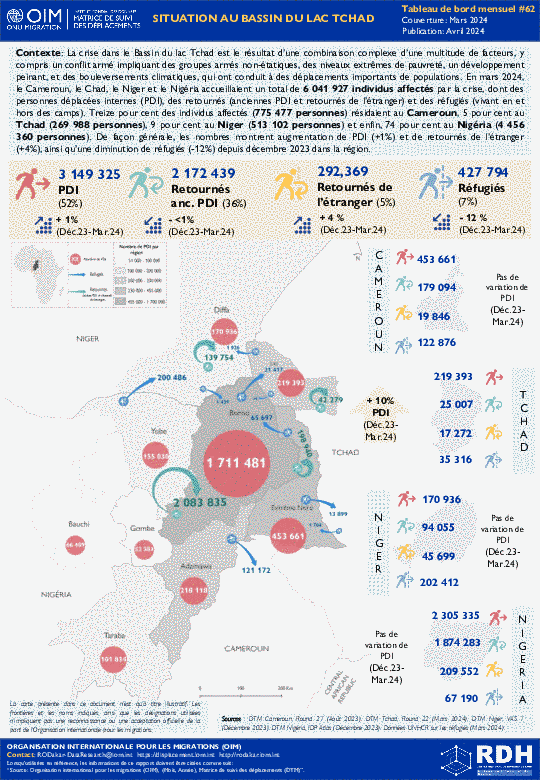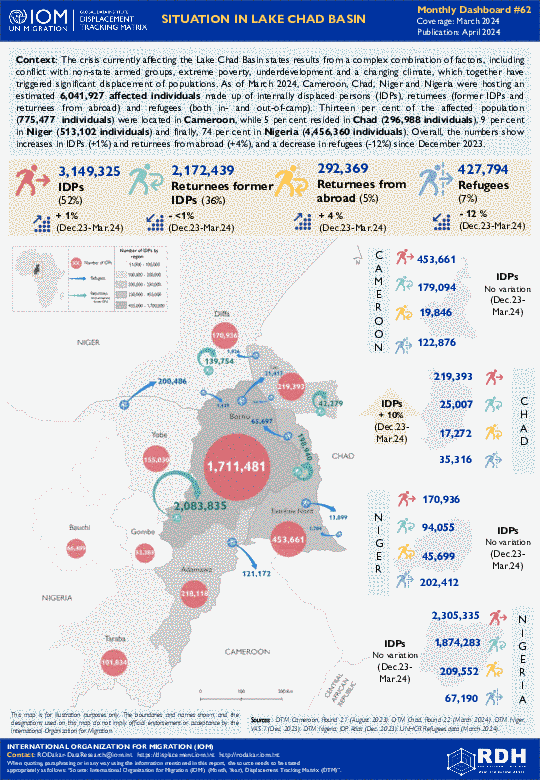-
Countries
-
Data and Analysis
-
Special Focus
-
Crisis Responses
La crise dans le Bassin du lac Tchad est le résultat d’une combinaison complexe d’une multitude de facteurs, y compris un conflit armé impliquant des groupes armés non-étatiques, des niveaux extrêmes de pauvreté, un développement peinant, et des bouleversements climatiques, qui ont conduit à des déplacements importants de populations. En mars 2024, le Cameroun, le Chad, le Niger et le Nigéria accueillaient un total de 6 041 927 individus affectés par la crise, dont des personnes déplacées internes (PDI), des retournés (anciennes PDI et retournés de l’étranger) et des réfugiés (vivant en et hors des camps). Treize pour cent des individus affectés (775 477 personnes) résidaient au Cameroun, 5 pour cent au Tchad (269 988 personnes), 9 pour cent au Niger (513 102 personnes) et enfin, 74 pour cent au Nigéria (4 456 360 personnes). De façon générale, les nombres montrent augmentation de PDI (+1%) et de retournés de l’étranger (+4%), ainsi qu’une diminution de réfugiés (-12%) depuis décembre 2023 dans la région.
The crisis currently affecting the Lake Chad Basin states results from a complex combination of factors, including conflict with non-state armed groups, extreme poverty, underdevelopment and a changing climate, which together have triggered significant displacement of populations. As of March 2024, Cameroon, Chad, Niger and Nigeria were hosting an estimated 6,041,927 affected individuals made up of internally displaced persons (IDPs), returnees (former IDPs and returnees from abroad) and refugees (both in- and out-of-camp). Thirteen per cent of the affected population (775,477 individuals) were located in Cameroon, while 5 per cent resided in Chad (296,988 individuals), 9 per cent in Niger (513,102 individuals) and finally, 74 per cent in Nigeria (4,456,360 individuals). Overall, the numbers show increases in IDPs (+1%) and returnees from abroad (+4%), and a decrease in refugees (-12%) since December 2023.
Contact
iomkyrgyzstan@iom.int
Location
Kyrgyzstan
Activity
- Mobility Tracking
Period Covered
Oct 18 2023 -Dec 22 2023
The dataset presents findings from surveys conducted in Kyrgyzstan using the International Organization for Migration's (IOM) Mobility Tracking Matrix (MTM) system. Adapted from IOM's Global Displacement Tracking Matrix (DTM) methodology, MTM aims to collect and analyze data to understand the mobility, vulnerabilities, and needs of displaced and mobile populations for evidence-based migration management. 9 regions were covered, 45 rayons were assessed, and 1,228 returned migrants were interviewed.
Population Groups
Other
Survey Methodology
Unit of Analysis Or Observation
Admin Area 2
Individual
Type of Survey or Assessment
Keywords
Geographical Scope Full Coverage
Administrative boundaries with available data
The current dataset covers the following administrative boundaries
Contact
iomkyrgyzstan@iom.int
Location
Kyrgyzstan
Activity
- Mobility Tracking
Period Covered
Jun 26 2023 -Aug 17 2023
The dataset presents findings from key informant interviews conducted in Kyrgyzstan using the International Organization for Migration's (IOM) Mobility Tracking Matrix (MTM) system. Adapted from IOM's Global Displacement Tracking Matrix (DTM) methodology, MTM aims to collect and analyze data to understand the mobility, vulnerabilities, and needs of displaced and mobile populations for evidence-based migration management. 9 regions were covered, 45 rayons were assessed, and 48,130 individuals were identified as having returned from abroad.
Population Groups
Migrants Present
Other
Survey Methodology
Unit of Analysis Or Observation
Admin Area 2
Admin Area 3
Other
Type of Survey or Assessment
Key Informant
Keywords
Geographical Scope Full Coverage
Administrative boundaries with available data
The current dataset covers the following administrative boundaries
Contact
DTMUKRAINE@IOM.INT
Location
Ukraine
Activity
- Mobility Tracking
Period Covered
Feb 01 2024 -Feb 29 2024
IOM's Data and Analytics (D&A) Unit developed the Mobility and Needs Assessment (MaNA), a monthly, multi-sectoral assessment designed to systematically monitor the estimated current presence of key population groups, including de facto Internally Displaced Persons (IDPs), returnees and non-displaced residents, at the hromada level. MaNA also offers a regular baseline for evaluating population needs at a granular level, with a specific focus on hard-to-reach areas. It utilizes sector specific indicators, serving as a compass to steer humanitarian programming and response efforts.
This report presents the primary findings from the sixth round of MaNA, conducted in February 2024 across 255 hromadas located in 23 oblasts and Kyiv City. Assessed hromadas were selected based on their relevance to humanitarian programming, pre-war population size, and known displacement trends.
This is a restricted dataset. To get access, kindly click on the 'Request Access' button.
Population Groups
IDPs
Residents
Returnee (Previously Internally Displaced)
Survey Methodology
Unit of Analysis Or Observation
Admin Area 2
Admin Area 3
Site or Location
Type of Survey or Assessment
Key Informant
Keywords
Geographical Scope Partial Coverage
Administrative boundaries with available data
The current dataset covers the following administrative boundaries
Contact
IOMKABULDTMALLUSERS@iom.int
Location
Afghanistan
Activity
- Mobility Tracking
- Site Assessment
Period Covered
Jan 25 2024 -Feb 29 2024
IOM Afghanistan launched the first round of the DTM Baseline Area Assessment B1 in January 2024 as part of its ongoing efforts to collect crucial data on population mobility dynamics, specifically displacement and returns. In particular, the B1 activity seeks to map the presence of mobile population groups, such as Internally Displaced Persons (IDPs), returnees, and internal migrants, to enable further understanding of conditions, vulnerabilities, and humanitarian needs through targeted data collection and analysis.
The community-level dataset is available based on request only, to get access kindly click on the 'Request Access' button.
Population Groups
IDPs
Returnee (Previously Displaced Abroad)
Returnee (Previously Internally Displaced)
Survey Methodology
Unit of Analysis Or Observation
Admin Area 2
Site or Location
Type of Survey or Assessment
Key Informant
Keywords
Geographical Scope Partial Coverage
Administrative boundaries with available data
The current dataset covers the following administrative boundaries

Contact
DTM Djibouti, DTMDjibouti@iom.int
Language
English
Location
Djibouti
Period Covered
Feb 01 2024
Feb 29 2024
Activity
- Flow Monitoring
En février 2024, 28 829 mouvements migratoires ont été observés aux points de suivi des flux (FMP) à Djibouti dont 14 483 individus entrants en provenance d’Éthiopie. Les mouvements migratoires observés ont augmenté de 7 pour cent en février par rapport à janvier liée à l’approche du mois de Ramadan généralement considéré comme une période idéale pour les migrants désireux de se rendre vers les pays
de la Péninsule Arabique.
Au cours de février, le nombre de migrants de retours spontanés ou forcés enregistrés dans les régions d’Obock et de Tadjourah a fortement augmenté de 123 pour cent passant de 775 en janvier à 1 730 en février dû principalement aux contrôles des autorités au niveau des côtes Yéménites.

Contact
DTM Djibouti, DTMDjibouti@iom.int
Language
English
Location
Djibouti
Period Covered
Feb 01 2024
Feb 29 2024
Activity
- Flow Monitoring
In February 2024, 28,829 migratory movements were observed at Djibouti's Flow Monitoring Points (FMPs), including 14,483 incoming individuals from Ethiopia. The observed migratory movements increased by 7 per cent in February compared with January, linked to the approach of the month of Ramadan, generally considered to be an ideal time for migrants wishing to travel to the countries in the Arabian
Peninsula.
During February, the number of spontaneous or forced return migrants recorded in the Obock and Tadjourah regions rose sharply by 123 per cent, from 775 in January to 1,730 in February, mainly due to checks by the authorities on the Yemeni coast.
Contact
DTM Sudan, DTMSudan@iom.int
Location
Sudan
Activity
- Mobility Tracking
- Baseline Assessment
Period Covered
Feb 22 2024 -Mar 21 2024
- DTM Sudan estimates that 6,552,118 individuals (1,308,617 households) have been recently internally displaced.
- IOM DTM also reports that an estimated 2,019,027 mixed cross-border movements have been made into neighbouring countries.
- Since 15 April 2023, 46 per cent of the IDP caseload sought refuge in the Darfur and Kordofan regions, whereas 53 per cent were observed across the Northern, Eastern, and Central states.
- The majority of the IDP caseload (66%) were seeking shelter with the host community.
- While food remains the highest priority need, health and non-food items are also growing concerns.
A more detailed version of this dataset is available, to get access kindly click on the 'Request Access' button
Population Groups
IDPs
Survey Methodology
Unit of Analysis Or Observation
Admin Area 3
Site or Location
Type of Survey or Assessment
Key Informant
Keywords
Geographical Scope Partial Coverage
Administrative boundaries with available data
The current dataset covers the following administrative boundaries
Contact
DTMAFGHANISTAN@iom.int
Location
Afghanistan
Activity
- Flow Monitoring Survey
Period Covered
Jan 10 2024 -Nov 16 2024
DTM Flow Monitoring, conducted by IOM Afghanistan, is designed to provide insights into the mobility patterns at Afghanistan’s border points with the Islamic Republic of Iran and Pakistan.
It is important to note that DTM collects information on total movements at a given border point, not the number of unique individuals entering or leaving the country. As a result, if one individual both left and re-entered Afghanistan during the reporting period, this would count as one outflow movement and one inflow movement.
DTM FM is operational at four main crossing points (connected to Afghanistan’s National Highway) as well as six other crossing points with Islamic Republic of Iran and Pakistan.
Population Groups
Migrants Present
Survey Methodology
Unit of Analysis Or Observation
Other
Type of Survey or Assessment
Keywords
Geographical Scope Partial Coverage
Administrative boundaries with available data
The current dataset covers the following administrative boundaries


